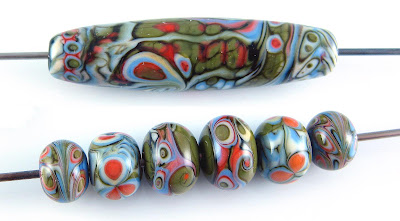1 - Plain, 2 - Plain (reduced), 3 - w/ Silver Leaf, 4 - w/ Silver Leaf (reduced & encased), 5 - w/ Silver Glass Frit (reduced), 6 - w/ Terranova2 Frit, 7 & 8 - w/ Tuxedo, Copper Green, Ivory and Peace
Effetre Opal Yellow is one of my favourite colours, and is on my list of colours where, if it were to suddenly be no longer available, I would be a very sad girl indeed. Opal Yellow is a very stable base colour, the only weird thing about it being that it tends to blush pink when either silver is added or it is struck repeatedly. It's versatile - there's almost nothing that you would want do do with a glass colour (apart from encase, since it's opaque) that you can't do with Opal Yellow. It makes a great base for silver glass, and because it is not super-reactive, it can be used in combinations with most other colours (with the possible exception of colours in the 'sulfur' family, like Ivory) without worry.
Here you can see how the Opal Yellow has gone quite pink after adding the silver. It's more pronounced in the bead on the left. The silver leaf when left unencased kinda sits on the surface of Opal Yellow and doesn't do anything all that magical. The appearance of it is not improved by encasing it - it turns it a light pink colour that is sort of lost against the yellow. OK, so there's one thng that Opal Yellow isn't so good at. :)
Opal Yellow loves silver glass. It's a great base colour for both striking and reducing silver glass colours. In both of my test beads, the silver glass got great colour and did exactly what I expected it to do.
When Tuxedo is used over Opal Yellow, it bleeds. You can see a faint blueish stain around my Tuxedo stringer work in the bead on the left. On top of Tuxedo, the edges of Opal Yellow look sort of indistinct and sort of like a milk moustache.
Opal Yellow is another colour that keeps Copper Green from getting that greyish film on it. My Copper Green in these beads looks bright and beautiful. The most interesting thing about Copper Green and Opal Yellow is the faint line that develops between them. When Opal Yellow is used on top of Copper Green, it develops a faint dark turquoise line around it. When instead Copper Green is used on top of Opal Yellow, the line that forms is more of an orange colour. In both cases, it is the colour used as an accent that develops a faint separation reaction.
We've seen this before in my test results for Ivory and Dark Ivory, but Opal Yellow and Ivory don't so much get along. Ivory tends to go grey on top of Opal Yellow.
Peace dots and lines on top of Opal Yellow get a rosy orangey look to the edges and separate slightly. As a result, they almost disappear on top of the bead. When Opal Yellow is used on top of Peace, it seems even more inclined than usual to blush a pinkish colour.
In this bead, I used Opal Yellow as the base colour for the frame. I then liberally striped it with Silvered Ivory Stringer. The rod of Opal Yellow I used here was from a strangely pale batch, and it really reacted with the Silvered Ivory, resulting in it having a very aged appearance to it.
This fun set is made with KUG Pea Green, CiM Phoenix, EFF Periwinkle and EFF Opal Yellow. I love the reactions in these beads, which seem to be mostly due to the Pea Green. I haven't tested Pea Green yet, but will someday soon. Kugler Pea Green used to be known as ASK Mediterranean Olive.
This is Opal Yellow with Precision 104 Black Pearl. I love the reactions.
This one is Opal Yellow with a rainbow wigwag, rainbow murrini, and Hades decoration.








Awesome as always Melanie!
ReplyDeleteOpal yellow is surely one of my favourites too. I never tried to use it in combination with ivory - very interessing! Thanks for sharing your test results, Melanie!
ReplyDeleteMichi